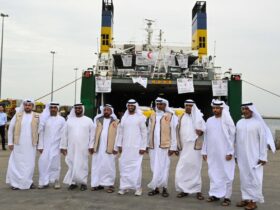Dubai – (Massader News )
The World Bank warned in a recent report that nearly 1.4 million children were at risk of imminent death from acute malnutrition, pointing out that nearly a million people were dying in Ethiopia in one of the worst famine in modern history, 30 years ago.
Today, conflict and drought are again contributing to a crisis that has put 20 million people in four countries on the brink of famine. This time, Ethiopia is not among them.
The country is still one of the world’s poorest. It is also coping with a devastating drought. But Ethiopia has been able to mute the impact by improving land and water management. It has also built resilience among people through a large safety net program supported by 11 donors including the World Bank’s International Development Association (IDA).
Since the safety net was established it 2005, it has allowed Ethiopia to break a cycle of annual appeals for emergency food assistance. Over the past year, the already large program has expanded in response to the drought to provide food, or the cash to buy it, for 18.2 million people.
Such safety net programs are being used in 149 developing and emerging countries to address social and economic inequalities.
They are also seen as a way to alleviate temporary hardships or even prevent humanitarian crises – such as those occurring right now in Somalia, South Sudan, Yemen and North East Nigeria.
These countries are facing famine or the risk of famine over the coming six months, according to the United Nations. An estimated 1.4 million children are at imminent risk of death from severe malnutrition.
And while famine can occur for numerous reasons, a common factor in the current famine is protracted conflict that has exacerbated vulnerabilities that existed before the crisis.
- In South Sudan, 1.9 million people have been internally displaced since December 2013, and another 1.7 million refugees have taken refuge in neighboring countries.
- In Yemen, conflict has disrupted the banking system and trade. The government has been unable to pay salaries or provide social benefits.
- In Somalia, the drought has worsened insecurity and driven unsafe migration known as ‘Tahrib’.
- In Northeast Nigeria, violence perpetrated by the terror group Boko Haram disrupted the supply of seeds, and unexploded devices in fields have prevented farmers from going back to planting.
What the World Bank is Doing
In response to the deteriorating situation in Sub-Saharan Africa and Yemen, World Bank Group President Jim Yong Kim called for urgent action in March.
“Famine is a stain on our collective conscience. Our first priority is to work with partners to make sure that families have access to food and water,” said Kim.
“But we must recognize that famine will have lasting impacts on people’s health, ability to learn, and earn a living. So we will also continue to work with communities to reclaim their livelihoods and build resilience to future shocks. To prevent crises in the future, we must invest in addressing the root causes and drivers of fragility today and help countries build institutional and societal resilience.”
The Bank is mobilizing $1.8 billion to build social protection systems, such as safety nets, and to strengthen community resilience and maintain service delivery to the most vulnerable.
More than $870 million from existing projects will be redirected to help communities threatened by famine in Northeast Nigeria and Yemen. In Nigeria, a series of projects is rebuilding institutions, re-establishing services and food supplies to encourage people to return to their homes.
About $930 million will be used for emergency food security projects, safety-net programs and agriculture and water programs in South Sudan, Yemen, Nigeria, Ethiopia and Kenya.
$283 million in grants from IDA, the Bank’s fund for the poorest countries, will respond to rising food insecurity in Yemen. That includes $125 million from the IDA Crisis Response Window to finance cash transfers to 1.5 million of the poorest households (about 8 million people) to enable them to purchase food, and to provide nutritious supplements to an additional 1 million of the most vulnerable Yemenis.
In Somalia, where over half the population is in need of humanitarian assistance, the World Bank is financing a $50 million emergency project to scale up the drought response and recovery effort in partnership with the International Committee of the Red Cross (ICRC) and the Food and Agriculture Organization (FAO).
Today, Bank projects in the poorest countries contain a mechanism to redirect funds for immediate response and recovery. IDA’s “Crisis Response Window” provides additional resources to help countries respond to severe economic stress, major natural disasters, public health emergencies, and epidemics.
Looking ahead, the Bank is working to shift from a focus on response to a culture of prevention by better leveraging its monitoring capacity, operational policies, and financing tools. The Bank is scaling up its work to address fragility, conflict and violence including detecting and preparing for risks before they become crises.
The Bank also works with countries to promote climate-smart agricultural practices, which enrich soil and make it more resistant to drought, as well as crop diversification.
Working with Humanitarian and Peace Partners
As the crisis has unfolded, many in the international community have acknowledged that resolving this challenge amid conflict will require close collaboration among humanitarian, development, peacebuilding and security actors, as well as national governments and others.
Violent conflict has spiked dramatically globally since 2010. About 80% of humanitarian needs are now caused by protracted conflict, underscoring the urgent need for global partners to help reduce the occurrence and impact of such shocks.
“Our goal is to do all we can together – using information technology, financial innovations, and creative partnerships —to relegate famines to the history books and leave no one behind,” said Kristalina Georgieva, CEO of the World Bank Group.
Some partners are present in areas that the global community cannot reach. Other partners can play a diplomatic and political role to encourage political leadership to address the root causes of conflict.
“We will also keep the longer term resilience agenda front and center, to protect and stimulate markets and livelihoods as much as possible, even as we address immediate life-saving priorities,” said Georgieva.
To foster a comprehensive response, United Nations Secretary-General António Guterres and President Kim co-chaired a high-level meeting on famine and fragility in April, at the World Bank Group Spring Meetings in Washington DC. About 50 leaders of multilateral development banks, UN agencies, donor partners, non-governmental organizations and others discussed ways to strengthen collaboration, especially on access, efficient delivery, and to mitigate and manage longer term risks.
The Bank and the UN also signed an agreement on April 22 to work together more closely to provide life-saving support and build resilience for the most vulnerable people by reducing poverty, promoting shared prosperity, enhancing food security, and sustaining peace in crisis-affected situations.
“It’s critically important to help countries prepare for these crises,” said Kim. “We’re working with the affected countries and partners to help end the famine – and we will use every tool we have, including financial tools, to prevent famine in the future.”
Focus Keywords
#Dubai Masaader News #Healthcare # Famine #World Bank











